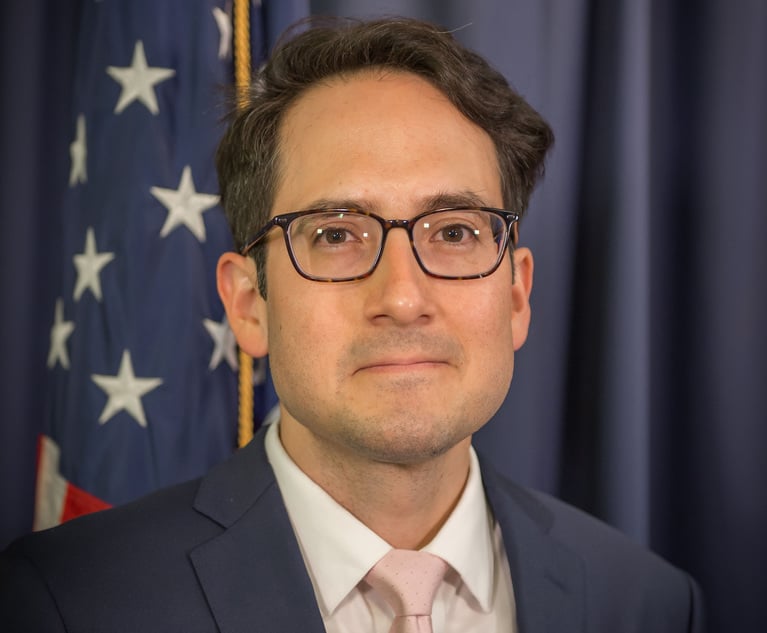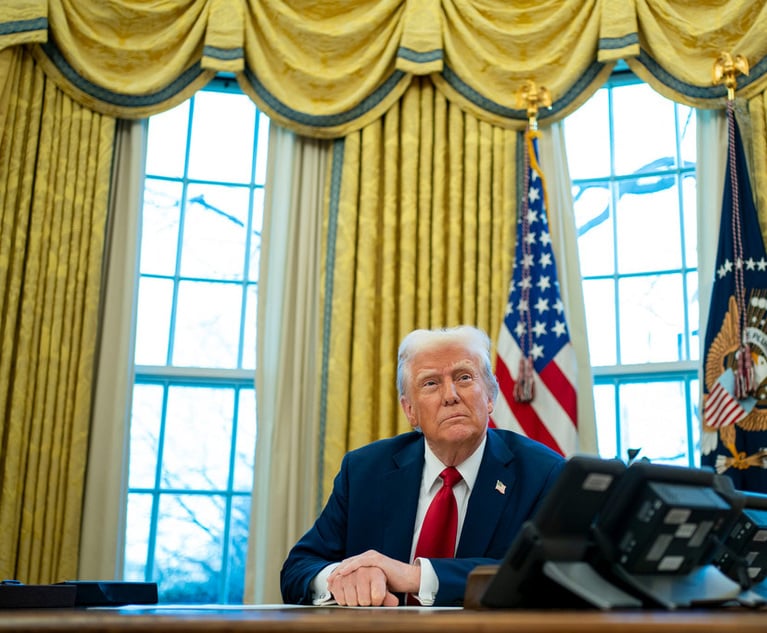Court clarifies standard for SEC aiding and abetting claims
2nd Circuit rejects standard that would have required agency to establish proximate causation to satisfy "substantial assistance" test
October 29, 2012 at 08:00 PM
7 minute read
The Securities and Exchange Commission's (SEC) enforcement program avoided a major blow in August as the 2nd Circuit reversed a decision that would have substantially raised the bar for aiding and abetting claims in SEC civil enforcement actions.
In an opinion authored by U.S. District Judge Jed Rakoff of the Southern District of New York, sitting by designation for the 2nd Circuit, the federal appeals court in Securities and Exchange Commission v. Joseph F. Apuzzo clarified and simplified the test for substantial assistance, one of the necessary components of aiding and abetting liability.
Most notably, the court rejected a standard that would have required the SEC to establish proximate causation to satisfy the “substantial assistance” test for making successful aiding and abetting claims.
“If Apuzzo had gone the other way … it would have been big trouble for the SEC,” says David Smyth, former assistant director of the SEC's Division of Enforcement and currently of counsel at Brooks, Pierce, McLendon, Humphrey & Leonard. “It would be just about as hard as proving a primary violation. They would have to show that the defendant was a critical link in the chain of the actual violation.”
Substantial Assistance
The SEC alleges that Joseph Apuzzo, former CFO of Terex Corp., helped another company, United Rentals Inc. (URI), carry out two fraudulent sale-leaseback transactions that allowed URI to recognize revenue prematurely and inflate sales profits. The commission brought an enforcement action against Apuzzo under Section 20(e) of the Securities Exchange Act of 1934, which allows SEC civil enforcement actions against aiders and abettors of securities fraud.
To establish aiding and abetting liability, the SEC must show the existence of a securities law violation by the primary party, knowledge of this violation on the part of the aider and abettor, and “substantial assistance” by the aider and abettor in the achievement of the primary violation.
In 2010, the U.S. District Court for the District of Connecticut granted Apuzzo's motion to dismiss, finding that the SEC had not adequately alleged the “substantial assistance” component of the claim.
The lower court said the SEC's factual allegations did support a “but for” causal relationship between Apuzzo's actions and the primary violation—i.e., that the fraud at URI would not have taken place without Apuzzo's conduct.
However, the district court concluded that substantial assistance required a showing that the aider and abettor “proximately caused” the harm on which the primary violation was predicated.
The 2nd Circuit reversed that opinion and set forth a clarified and simplified test for evaluating substantial assistance, citing a standard crafted by Judge Learned Hand in a 1938 opinion and later adopted by the Supreme Court.
The test in securities fraud cases, the 2nd Circuit held, is that the aider and abettor “in some sort associated himself with the venture, that he participated in it as in something that he wished to bring about, and that he sought by his action to make it succeed.”
That “clear, concise and workable” standard has stood the test of time as the classic formula for aider and abettor liability, Judge Rakoff wrote.
“The court's ruling really reaffirms the SEC's historic position that it doesn't have to prove causation in its cases,” says Thomas Gorman, a partner at Dorsey & Whitney and former SEC Division of Enforcement staff member. “If they had to do that, it would have created substantial difficulty.”
Deterrence vs. Compensation
Previously, Judge Rakoff wrote, the 2nd Circuit had established a proximate cause standard—but only for private tort actions (and prior to the Supreme Court's 1994 ban on private plaintiff claims for aiding and abetting securities fraud in Central Bank of Denver, N.A. v. First Interstate Bank of Denver, N.A.).
However, he said, in civil or criminal enforcement actions the government does not have to prove injury “because the purpose of such actions is deterrence, not compensation.”
Further, Judge Rakoff reasoned, Section 20(e) of the Securities Exchange Act of 1934, under which the SEC brought its claim against Apuzzo, was passed in 1994, in the wake of Central Bank, for the purpose of allowing the SEC to target aiders and abettors who “were not they themselves involved in the making of the false statements that proximately caused the plaintiffs' injuries.” A proximate causation standard would undercut that statutory mandate.
And as Judge Rakoff's decision notes, because private plaintiffs can't bring claims for aiding and abetting securities law violations, “many if not most aiders and abettors would escape all liability if such a proximate cause requirement were imposed [on the SEC], since, almost by definition, the activities of an aider and abettor are rarely the direct cause of the injury brought about by the fraud, however much they contribute to the success of the scheme.”
Carrot and Stick
To raise the bar would have had a particularly substantial impact on the SEC in light of recent developments that have led the commission to bring more aiding and abetting claims. In 2010, the Dodd-Frank Wall Street Reform and Consumer Protection Act lowered the standard for SEC aiding and abetting claims to include violators of the securities laws that act in “reckless disregard” of the truth, whereas previously some circuits required outright knowledge. In addition, the Supreme Court's June 2011 decision in Janus Capital Group, Inc. v. First Derivative Traders narrowed the scope of primary liability under SEC Rule 10b-5.
“Dodd-Frank … was the carrot guiding the SEC toward making more aiding and abetting claims. The stick was the Janus Capital Group case, which meant the SEC had to draw some pretty careful lines regarding whom they were going to charge, and that they were going to have to dust off this aiding and abetting statute more often than they had been used to,” Smyth says.
Apuzzo is a good example of the SEC's willingness to pursue such aiding and abetting cases involving conduct on the margins: Apuzzo was not an employee or representative of the party accused of engaging in fraudulent conduct. He worked for another company and is alleged to have played along with the scheme.
“The fact that the SEC brought this case in and of itself indicates that the SEC is willing to be aggressive and proactive in asserting claims for aiding and abetting,” says Peter Haveles, a partner in the complex commercial litigation department at Kaye Scholer. “Apuzzo enables the SEC to proceed with more confidence that it can succeed in bringing these cases.”
Although no court has yet addressed the merits of the Securities and Exchange Commission's (SEC) case against Joseph Apuzzo, the factual scenario presented in the allegations, along with the clarified SEC standard, provides a good red flag—one should always be careful regarding transactions that are geared too much toward revenue recognition, says Peter Haveles, a partner at Kaye Scholer.
This content has been archived. It is available through our partners, LexisNexis® and Bloomberg Law.
To view this content, please continue to their sites.
Not a Lexis Subscriber?
Subscribe Now
Not a Bloomberg Law Subscriber?
Subscribe Now
NOT FOR REPRINT
© 2025 ALM Global, LLC, All Rights Reserved. Request academic re-use from www.copyright.com. All other uses, submit a request to [email protected]. For more information visit Asset & Logo Licensing.
You Might Like
View All
GOP Now Holds FTC Gavel, but Dems Signal They'll Be a Rowdy Minority
6 minute read
Longtime Purdue GC Accused of Drunken Driving Hires Big-Name Defense Attorney
3 minute read
Fired by Trump, EEOC's First Blind GC Lands at Nonprofit Targeting Abuses of Power
3 minute read
Trump's Inspectors General Purge Could Make Policy Changes Easier, Observers Say
Trending Stories
- 1Unit Owners Sued Board For Failure To Maintain Adequate Fire Insurance: This Week In Scott Mollen’s Realty Law Digest
- 2NY Judge Resigns After Avoiding Jury Duty by Telling Court He Couldn't Be Impartial
- 3'Serious Legal Errors'?: Rival League May Appeal Following Dismissal of Soccer Antitrust Case
- 4Longtime Purdue GC Accused of Drunken Driving Hires Big-Name Defense Attorney
- 5Eight Years On, A&O Shearman’s Fuse Legal Tech Incubator Is Still Evolving
Who Got The Work
J. Brugh Lower of Gibbons has entered an appearance for industrial equipment supplier Devco Corporation in a pending trademark infringement lawsuit. The suit, accusing the defendant of selling knock-off Graco products, was filed Dec. 18 in New Jersey District Court by Rivkin Radler on behalf of Graco Inc. and Graco Minnesota. The case, assigned to U.S. District Judge Zahid N. Quraishi, is 3:24-cv-11294, Graco Inc. et al v. Devco Corporation.
Who Got The Work
Rebecca Maller-Stein and Kent A. Yalowitz of Arnold & Porter Kaye Scholer have entered their appearances for Hanaco Venture Capital and its executives, Lior Prosor and David Frankel, in a pending securities lawsuit. The action, filed on Dec. 24 in New York Southern District Court by Zell, Aron & Co. on behalf of Goldeneye Advisors, accuses the defendants of negligently and fraudulently managing the plaintiff's $1 million investment. The case, assigned to U.S. District Judge Vernon S. Broderick, is 1:24-cv-09918, Goldeneye Advisors, LLC v. Hanaco Venture Capital, Ltd. et al.
Who Got The Work
Attorneys from A&O Shearman has stepped in as defense counsel for Toronto-Dominion Bank and other defendants in a pending securities class action. The suit, filed Dec. 11 in New York Southern District Court by Bleichmar Fonti & Auld, accuses the defendants of concealing the bank's 'pervasive' deficiencies in regards to its compliance with the Bank Secrecy Act and the quality of its anti-money laundering controls. The case, assigned to U.S. District Judge Arun Subramanian, is 1:24-cv-09445, Gonzalez v. The Toronto-Dominion Bank et al.
Who Got The Work
Crown Castle International, a Pennsylvania company providing shared communications infrastructure, has turned to Luke D. Wolf of Gordon Rees Scully Mansukhani to fend off a pending breach-of-contract lawsuit. The court action, filed Nov. 25 in Michigan Eastern District Court by Hooper Hathaway PC on behalf of The Town Residences LLC, accuses Crown Castle of failing to transfer approximately $30,000 in utility payments from T-Mobile in breach of a roof-top lease and assignment agreement. The case, assigned to U.S. District Judge Susan K. Declercq, is 2:24-cv-13131, The Town Residences LLC v. T-Mobile US, Inc. et al.
Who Got The Work
Wilfred P. Coronato and Daniel M. Schwartz of McCarter & English have stepped in as defense counsel to Electrolux Home Products Inc. in a pending product liability lawsuit. The court action, filed Nov. 26 in New York Eastern District Court by Poulos Lopiccolo PC and Nagel Rice LLP on behalf of David Stern, alleges that the defendant's refrigerators’ drawers and shelving repeatedly break and fall apart within months after purchase. The case, assigned to U.S. District Judge Joan M. Azrack, is 2:24-cv-08204, Stern v. Electrolux Home Products, Inc.
Featured Firms
Law Offices of Gary Martin Hays & Associates, P.C.
(470) 294-1674
Law Offices of Mark E. Salomone
(857) 444-6468
Smith & Hassler
(713) 739-1250






